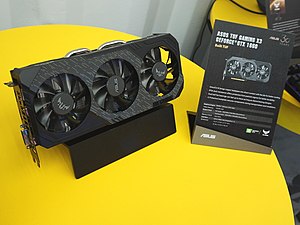
GeForce is a brand of graphics processing units (GPUs) designed by Nvidia and marketed for the performance market. As of the GeForce 40 series, there have been eighteen iterations of the design. The first GeForce products were discrete GPUs designed for add-on graphics boards, intended for the high-margin PC gaming market, and later diversification of the product line covered all tiers of the PC graphics market, ranging from cost-sensitive GPUs integrated on motherboards, to mainstream add-in retail boards. Most recently, GeForce technology has been introduced into Nvidia's line of embedded application processors, designed for electronic handhelds and mobile handsets.

Alienware Corporation is an American computer hardware subsidiary brand of Dell. Their product range is dedicated to gaming computers and accessories and can be identified by their alien-themed designs. Alienware was founded in 1996 by Nelson Gonzalez and Alex Aguila. The development of the company is also associated with Frank Azor, Arthur Lewis, Joe Balerdi, and Michael S. Dell (CEO). The company's corporate headquarters is located in The Hammocks, Miami, Florida.
The GeForce 500 series is a series of graphics processing units developed by Nvidia, as a refresh of the Fermi based GeForce 400 series. It was first released on November 9, 2010 with the GeForce GTX 580.

The GeForce 900 series is a family of graphics processing units developed by Nvidia, succeeding the GeForce 700 series and serving as the high-end introduction to the Maxwell microarchitecture, named after James Clerk Maxwell. They were produced with TSMC's 28 nm process.
The GeForce 10 series is a series of graphics processing units developed by Nvidia, initially based on the Pascal microarchitecture announced in March 2014. This design series succeeded the GeForce 900 series, and is succeeded by the GeForce 16 series and GeForce 20 series using the Turing microarchitecture.

Pascal is the codename for a GPU microarchitecture developed by Nvidia, as the successor to the Maxwell architecture. The architecture was first introduced in April 2016 with the release of the Tesla P100 (GP100) on April 5, 2016, and is primarily used in the GeForce 10 series, starting with the GeForce GTX 1080 and GTX 1070, which were released on May 27, 2016, and June 10, 2016, respectively. Pascal was manufactured using TSMC's 16 nm FinFET process, and later Samsung's 14 nm FinFET process.
Nvidia NVENC is a feature in Nvidia graphics cards that performs video encoding, offloading this compute-intensive task from the CPU to a dedicated part of the GPU. It was introduced with the Kepler-based GeForce 600 series in March 2012.
Graphics Double Data Rate 6 Synchronous Dynamic Random-Access Memory is a type of synchronous graphics random-access memory (SGRAM) with a high bandwidth, "double data rate" interface, designed for use in graphics cards, game consoles, and high-performance computing. It is a type of GDDR SDRAM, and is the successor to GDDR5. Just like GDDR5X it uses QDR in reference to the write command clock (WCK) and ODR in reference to the command clock (CK).

Nvidia RTX is a professional visual computing platform created by Nvidia, primarily used in workstations for designing complex large-scale models in architecture and product design, scientific visualization, energy exploration, and film and video production, as well as being used in mainstream PCs for gaming.

The GeForce 20 series is a family of graphics processing units developed by Nvidia. Serving as the successor to the GeForce 10 series, the line started shipping on September 20, 2018, and after several editions, on July 2, 2019, the GeForce RTX Super line of cards was announced.

Turing is the codename for a graphics processing unit (GPU) microarchitecture developed by Nvidia. It is named after the prominent mathematician and computer scientist Alan Turing. The architecture was first introduced in August 2018 at SIGGRAPH 2018 in the workstation-oriented Quadro RTX cards, and one week later at Gamescom in consumer GeForce 20 series graphics cards. Building on the preliminary work of Volta, its HPC-exclusive predecessor, the Turing architecture introduces the first consumer products capable of real-time ray tracing, a longstanding goal of the computer graphics industry. Key elements include dedicated artificial intelligence processors and dedicated ray tracing processors. Turing leverages DXR, OptiX, and Vulkan for access to ray tracing. In February 2019, Nvidia released the GeForce 16 series GPUs, which utilizes the new Turing design but lacks the RT and Tensor cores.
Ampere is the codename for a graphics processing unit (GPU) microarchitecture developed by Nvidia as the successor to both the Volta and Turing architectures. It was officially announced on May 14, 2020 and is named after French mathematician and physicist André-Marie Ampère.

RDNA 2 is a GPU microarchitecture designed by AMD, released with the Radeon RX 6000 series on November 18, 2020. Alongside powering the RX 6000 series, RDNA 2 is also featured in the SoCs designed by AMD for the PlayStation 5, Xbox Series X/S, and Steam Deck consoles.

The GeForce 30 series is a suite of graphics processing units (GPUs) designed and marketed by Nvidia, succeeding the GeForce 20 series. The GeForce 30 series is based on the Ampere architecture, which features Nvidia's second-generation ray tracing (RT) cores and third-generation Tensor Cores. Through Nvidia RTX, hardware-enabled real-time ray tracing is possible on GeForce 30 series cards.

The Radeon RX 6000 series is a series of graphics processing units developed by AMD, based on their RDNA 2 architecture. It was announced on October 28, 2020 and is the successor to the Radeon RX 5000 series. It consists of the entry-level RX 6400, mid-range RX 6500 XT, high-end RX 6600, RX 6600 XT, RX 6650 XT, RX 6700, RX 6700 XT, upper high-end RX 6750 XT, RX 6800, RX 6800 XT, and enthusiast RX 6900 XT and RX 6950 XT for desktop computers; and the RX 6600M, RX 6700M, and RX 6800M for laptops. A sub-series for mobile, Radeon RX 6000S, was announced in CES 2022, targeting thin and light laptop designs.

The GeForce 40 series is the most recent family of consumer-level graphics processing units developed by Nvidia, succeeding the GeForce 30 series. The series was announced on September 20, 2022, at the GPU Technology Conference (GTC) 2022 event, and launched on October 12, 2022, starting with its flagship model, the RTX 4090.
Ada Lovelace, also referred to simply as Lovelace, is a graphics processing unit (GPU) microarchitecture developed by Nvidia as the successor to the Ampere architecture, officially announced on September 20, 2022. It is named after the English mathematician Ada Lovelace, one of the first computer programmers. Nvidia announced the architecture along with the GeForce RTX 40 series consumer GPUs and the RTX 6000 Ada Generation workstation graphics card. The Lovelace architecture is fabricated on TSMC's custom 4N process which offers increased efficiency over the previous Samsung 8 nm and TSMC N7 processes used by Nvidia for its previous-generation Ampere architecture.

The Radeon RX 7000 series is a series of graphics processing units developed by AMD, based on their RDNA 3 architecture. It was announced on November 3, 2022 and is the successor to the Radeon RX 6000 series. The first two graphics cards of the family were released on Dec 13, 2022.










